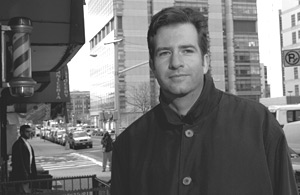Hunting the origin of Alzheimers
By Mike Perricone
Former particle physicist Christian Habeck conducts neuroimaging analysis seeking early detection of Alzheimer’s disease.
|
A surgeon and a scratch golfer most of his adult life, a US Army officer in World War II, the doctor gave up his medical practice in his 60s while exhibiting increasingly erratic behavior–such as meandering down to a favorite car dealer in his prosperous New Jersey town, and signing the papers for another new luxury model every couple of months. Many in the town saw the changes in the doctor, including new behaviors that were less benign; the owner of the dealership simply tore up the papers after each visit. At age 72, the doctor forgot how to walk. Other routine functions followed in slipping from memory, as did the recognition of those around him. The doctor’s end time was spent in a nursing home in Chicago, where his wife had relocated to be close to five of their children. The doctor continued fading, physically and mentally. After his death in 1987, at age 84, an autopsy showed a brain smothered in gum-like plaque and string-like tangles, defined as the source of Alzheimer’s disease.
 |
Christian Habeck wants to alter the course of the 4.5 million Alzheimer’s cases across the United States today–cases like the former physician wandering down to the car dealer. Cases like the 80-year-old man who disappeared from Atlanta’s international airport in 2004, turning up more than 24 hours later at the downtown bus station. Cases like the one in his own family.
"I know what it can be like as a concerned relative, since my grandmother became demented in the last years of her life," Habeck says. "Friends and family do not recognize their loved ones any longer, and the loved one does not exist any more in the way that he or she used to. It is truly horrible to only see the empty shell of a husband or wife you love, and used to be able to connect with for more than 30 years, without getting through anymore."
Originally a particle physicist, Habeck now conducts neuroimaging and analysis research that could help change the future for Alzheimer’s victims. He works with a group headed by Richard Mayeux at the Taub Institute for Research on Alzheimer’s Disease and the Aging Brain, at Columbia University’s College of Physicians and Surgeons in New York City. Habeck, 35, studied physics at Siegen University in Germany, and then took his master’s degree in particle theory at Durham University in the United Kingdom. He became an experimentalist at Sussex University, his PhD thesis involving neutron decay; he was also broadening his outlook.
"The nice thing about working in low-energy particle physics," he says, "is that you get a bit of a ‘Jack of all trades, master of none’ exposure to a lot of different things: vacuum techniques, cryogenics, electronics, high magnetic and electric fields, higher-order calculation of Feynman diagrams, crane driving, and so on. I always felt this was a lot more fun than doing a PhD as part of a big collaboration at one of the big accelerators."
Expanding his range of interests, he took a postdoctoral position in theoretical neuroscience at The Neurosciences Institute in La Jolla, California. At the 1999 conference of the Society for Neuroscience in Miami, he met Yaakov Stern, a group leader of the Cognitive Neuroscience Division in the Taub Institute. Stern invited him to Columbia University for a year, "to see how things go." Habeck arrived in New York City in 2000. Things went well.
Unconventional analysis
With the Mayeux group at the Taub Institute, Habeck uses what is still regarded as the "unconventional" approach of multivariate analysis in neuroimaging. Examining brain scans, he searches for signs that could predict who will be stricken with Alzheimer’s among the people in the Mayeux survey–the largely Dominican population in the neighborhood surrounding the Taub Institute.
|
The Washington Heights neighborhood in upper Manhattan, with the George Washington Bridge in view, is a thoroughly Dominican environment. Two decades ago, Richard Mayeux examined a survey of elderly people there. He found that by about a factor of three, the Dominicans were the most likely to suffer from Alzheimer’s. In 1988, he extended a study of that population to family members in the Dominican Republic, where he and his survey team make regular visits to administer medical examinations and neuropsychological tests. This group is invaluable for its relative lack of genetic diversity. The Dominican population has stayed close together, creating a nearly ideal subject as Mayeux focuses on the genetics involved in the transmission of Alzheimer’s.
William Thies, senior scientist and vice president for medical and scientific affairs at the Chicago-based Alzheimer’s Association, has a high regard for the Mayeux effort. "Richard is able to make observations about the presence or absence of Alzheimer’s in this specific Hispanic population," Thies says, "and then compare it with other populations in New York City, which gives the beginnings of hints of the genetic background for Alzheimer’s. It’s clear that this is complex [in origin], and not a single gene. Most people have a rather diffuse background, so sorting out which genes leave you more susceptible, and which may protect you, is a difficult task. This work is right at the edge of our ability to analyze genetic information."
While Mayeux tries to map genetics of transmission, Habeck works at the precise stage where brain images and neuropsychological tests have not yet determined whether a subject has Alzheimer’s. Striving toward early diagnosis and treatment, Habeck examines cerebral blood flow patterns from functional magnetic resonance images, applying multivariate analysis.
Functional MRI records the increase in blood flow accompanying neural activity in the brain. Habeck explains the "unconventional" next step: "Multivariate analysis means looking for activity patterns in the brain that show correlation between different regions. Rather than looking at how each image element or ‘voxel,’ analogous to pixel, behaves on its own, without any relation to any other voxel, multivariate techniques take the interregional correlation in the brain into account. We look for ‘networks’ that show increased or decreased responses as a function of disease or cognitive challenge in concert. So, for instance, rather than looking at the anterior and posterior cortex independently, the use of multivariate techniques might tell you that they both ‘communicate’ with one another, and show how they are functionally connected. Maybe they display a positive correlation: when one increases in activity the other follows suit. Or maybe they display a negative correlation: when one increases, the other shuts down."
Habeck views the interregional correlation as critical: "Before the onset of some obvious focal blood flow deficit in the course of the disease, in which one area shows an obvious lack in blood flow, it seems that several areas show subtle deficits that are all occurring in concert. Univariate or naked-eye diagnostics might be fooled, and not detect these subtle, but statistically robust, disease-related changes. That’s what we are trying to overcome."
Hopes for early detection
Alzheimer’s disease was first described in a 1906 paper by Alois Alzheimer of the Anatomical Laboratory at the University of Munich in Germany. Examining the autopsied brain of a dementia patient he had previously treated at an asylum, Alzheimer found the plaque and tangles that he identified as the cause of the dementia. Mayeux and other Alzheimer’s researchers suspect a long developmental period before symptoms express themselves.
 |
|
 |
 |
 |
|
| The population of Washington Heights is nearly 75% Hispanic, according to the US Census in 2000. There are many small churches in the neighborhood (above), while the billboard (top) promises: "Maximum Refund Guaranteed, or your tax preparation is free." While old buildings in the neighborhood retain elegant architectural details (above: middle photos), many storefronts are shuttered with corrugated steel curtains. | |
Mayeux envisions Habeck’s work in early detection being applied to healthy young people with family histories or genetic predispositions. "It could be used," Mayeux says, "to better tease apart genetic and environmental causes of Alzheimer’s…to answer these important questions: Are there already different blood flow patterns in young, healthy people as a function of their genetic risk status? Or are both blood flow patterns quite similar and diverge later in life, possibly exacerbated by different lifestyles? Also, Dr. Habeck’s work might help address the as-yet-poorly-understood causal relationship between reduced blood flow, on the one hand; and Alzheimer’s pathophysiology–the plaques and tangles–on the other hand."
With an aging population, increasing life spans and decreasing fertility rates in this country, the US Census Bureau estimates that the number of persons 65 and older will increase from 35 million in 2000, to 71 million in 2030. The correlations are alarming for the possible increase in Alzheimer’s victims: A 2003 study from the Rush Institute on Healthy Aging and the Rush Alzheimer’s Disease Center in Chicago says the prevalence of Alzheimer’s disease in the United States will increase from 4.5 million in 2000, to between 11 and 16 million by 2050. Healthcare costs for treating Alzheimer’s disease in the United States are at least $100 billion annually.
"If we don’t figure out a way to deflect what happens due to demographics over the next 40 years, we will have a level of Alzheimer’s we just cannot handle," says Thies. "It will bankrupt our healthcare system, and overwhelm our facilities and infrastructure. It will be a terrible thing for society. Finding a way to develop early diagnosis and preventive treatments are essential for the welfare of the world, and of this country particularly."
Different skill set
The genetics of transmission, and the quest for early diagnosis and treatment, generate huge data sets, requiring mathematical skills that Thies describes as "not necessarily a traditional skill for people trained in biology" but a natural fit for physicists. Yet Habeck found his own skills tested.
"My observations," he says, "and here I have to stress that I talk as an outsider, are that Alzheimer’s and neurological disease in general are very individually variable, both from the point of view of clinical presentation and progression, as well as psychological coping mechanisms. That’s the scientific lesson for somebody who makes the transition from elementary particle physics to the life sciences: ‘noise’ and individual differences are important, and necessitate the use of inferential statistics in a way that I was not used to from my physics studies."
Habeck embraces the lesson, and his new field. "There are many smart people addressing this illness worldwide at all levels, and we have the necessary resources," he says. "We will have it licked sooner or later." He doubts he would return to particle physics, though he is certain he would choose physics again as a university freshman.
"In addition to the subject matter," Habeck says, "I had wonderful mentors all the way from my undergraduate to my postgraduate career stage. All of them were of the highest intellectual and human caliber." In their own way, they sent him off toward what could be his life challenge–making a difference for a wandering physician, an elderly man lost in an airport, a grandmother lost in a haze.
Click here to download the pdf version of this article.







